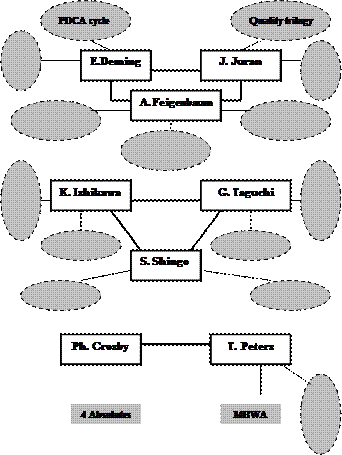| Statements
| T
| F
|
| 1. Quality management can be considered to have three main components: quality control, quality assurance and quality improvement.
| | |
| 2. Quality management is focused on product and service quality and does not consider the means to achieve it.
| | |
| 3. Quality Assurance differs from Quality Control in that Quality Assurance is the prevention of defects, while Quality Control is the detection of defects.
| | |
| 4. Quality Improvement can be distinguished from Quality Control in that Quality Improvement is the purposeful change of a process to improve the reliability of achieving an outcome.
| | |
| 5. After the second world war, China decided to make quality improvement a national imperative as part of rebuilding their economy, and sought the help of Deming and Juran, amongst others.
| | |
| 6. Examination of non-measurable data such as a firm's reputation, a brand image, or a customer's feelings about a product is called quantitative analysis.
| | |
| 7. Taguchi methods are statistical oriented methods including quality robustness, quality loss function, and target specifications.
| | |
| 8. It was A. Feigenbaum who encouraged the Japanese to adopt a systematic approach to problem solving, which later became known as PDCA cycle.
| | |
| 9. Shigeo Shingo's name is best known in relation to the concepts of Do It Right First time and Zero Defects.
| | |
| 10. There are many methods for quality improvement. These cover product improvement, process improvement and people based improvement
| | |
4 Do you remember which of the notable quality gurus:
| a Edwards Deming
| e Genichi Taguchi
|
| b Joseph Juran
| f Shigeo Shingo
|
| c Armand Feigenbaum
| g Philip Crosby
|
| d Kaoru Ishikawa
| h Tom Peters
|
made the following contribution to quality management theory?
| | a
| b
| c
| d
| e
| f
| g
| h
|
| 1 developed the idea of quality trilogy: quality planning, quality improvement and quality control
| | | | | | | | |
| 2 in 1979 published the book “Quality is free” where he popularized the idea of the "cost of poor quality"
| | | | | | | | |
| 3 defined the Four Absolutes of Quality Management
| | | | | | | | |
| 4 encouraged the Japanese to adopt a systematic approach to problem solving, which later became known as PDCA Cycle
| | | | | | | | |
| 5 devised the concept of Total Quality Control
| | | | | | | | |
| 6 initiated the Zero Defects program at the Martin Company Orlando, Florida, plant
| | | | | | | | |
| 7 invented SMED system and in 1969 cut the setup time on a 1000 ton press at Toyota from 4.0 hours to 3.0 minutes
| | | | | | | | |
| 8 designed McKinsey 7-S model as a platform onto which the research and theorising were built
| | | | | | | | |
| 9 focused on Quality Control as an integral part of Quality Management in his lectures to the Japanese in the early 1950s
| | | | | | | | |
| 10 over forty years ago published the book in which he presented 10 attributes that are still critical to organizations today
| | | | | | | | |
| 11 introduced a special type of a diagram to identify potential factors causing an overall effect
| | | | | | | | |
| 12 developed a method of controlling quality that emphasizes robust quality design and the quality loss function (QLF)
| | | | | | | | |
| 13 in 1982 published an international bestselling book “In Search of Excellence”
| | | | | | | | |
| 14 offered fourteen key principles for management for transforming business effectiveness
| | | | | | | | |
| 15 received the Blue Ribbon Award from the Emperor of Japan in 1990 for his contribution to industry
| | | | | | | | |
Transfer information of the text in note form to the following chart describing contribution to quality management theory by eminent specialists. Some have been done for you. Add circles if needed.






